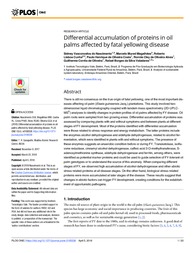Differential accumulation of proteins in oil palms affected by fatal yellowing disease.
Differential accumulation of proteins in oil palms affected by fatal yellowing disease.
Autoria: NASCIMENTO, S. V. do; MAGALHAES, M. M.; CUNHA, R. L.; COSTA, P. H. de O.; ALVES, R. C. de O.; OLIVEIRA, G. C. de; VALADARES, R. B. da S.
Resumo: There is still no consensus on the true origin of fatal yellowing, one of the most important diseases affecting oil palm (Elaeis guineensis Jacq.) plantations. This study involved two-dimensional liquid chromatography coupled with tandem mass spectrometry (2D-UPLC-MSE) analyses to identify changes in protein profiles of oil palms affected by FY disease. Oil palm roots were sampled from two growing areas. Differential accumulation of proteins was assessed by comparing plants with and without symptoms and between plants at different stages of FY development. Most of the proteins identified with differential accumulation were those related to stress response and energy metabolism. The latter proteins include the enzymes alcohol dehydrogenase and aldehyde dehydrogenase, related to alcohol fermentation, which were identified in plants with and without symptoms. The presence of these enzymes suggests an anaerobic condition before or during FY. Transketolase, isoflavone reductase, cinnamyl alcohol dehydrogenase, caffeic acid 3-O-methyltransferase, S-adenosylmethionine synthase, aldehyde dehydrogenase and ferritin, among others, were identified as potential marker proteins and could be used to guide selection of FY-tolerant oil palm genotypes or to understand the source of this anomaly. When comparing different stages of FY, we observed high accumulation of alcohol dehydrogenase and other abiotic stress related-proteins at all disease stages. On the other hand, biological stress-related proteins were more accumulated at later stages of the disease. These results suggest that changes in abiotic factors can trigger FY development, creating conditions for the establishment of opportunistic pathogens.
Ano de publicação: 2018
Tipo de publicação: Artigo de periódico
Unidade: Embrapa Amazônia Oriental
Palavras-chave: Amarelecimento fatal, Doença, Palma de óleo, Proteína
Observações
1 - Por padrão são exibidas publicações dos últimos 20 anos. Para encontrar publicações mais antigas, configure o filtro ano de publicação, colocando o ano a partir do qual você deseja encontrar publicações. O filtro está na coluna da esquerda na busca acima.
2 - Para ler algumas publicações da Embrapa (apenas as que estão em formato ePub), é necessário ter, no celular ou computador, um desses softwares gratuitos. Sistemas Android: Google Play Livros; IOS: iBooks; Windows e Linux: software Calibre.
Acesse outras publicações
Acesse a Base de Dados da Pesquisa Agropecuária (BDPA) para consultar o acervo completo das bibliotecas da Embrapa.

